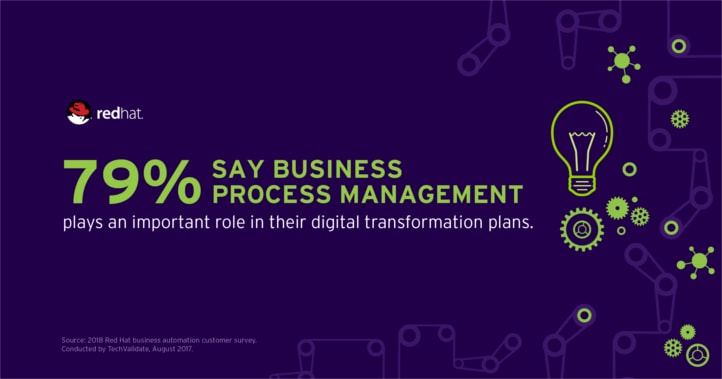Over the past decade we have witnessed a dramatic shift in the way organizations are conducting business, and the pivots they are making in order to become more agile and efficient. This has been matched by a marked shift in IT as technology increasingly plays a central role in driving these changes through the process of digital transformation.

Automation is one of the key capabilities supporting this transformation. From a business standpoint, eliminating the need for manual (i.e., human) intervention in complex or repetitive business processes can have a positive impact on operations. By automating certain decisions, organizations can not only accelerate process workflows but also improve the accuracy and consistency of the results.
The concept of business automation is not new, but the technologies continue to evolve to meet changing business demands. Ultimately, the value of these technologies can manifest itself as an increase in agility, e.g., operational efficiency, time-to-market, or market and customer demand; a more responsive and personalized customer experience; and lower costs.
In August 2017, we polled a selection of Red Hat customers to learn more about their motivations for adopting business automation technologies and how they are using them, as well as the role these technologies play in respondents' digital transformation initiatives.
Based on the results of this survey, respondents appear to have a firm grasp of the benefits offered by business automation, although they identified a broad range of priorities driving their adoption of this technology. When asked about their primary motivation, 34 percent indicated that their organization has adopted business process management (BPM) technology—one of the core capabilities of business automation—to improve operational efficiency. Another 24 percent identified the need to improve customer experience, and 15 percent said they are seeking to lower the cost of operational processes.
To accomplish these goals, respondents are applying this technology within their organization as a means of automating internal processes (57 percent); supporting new applications (46 percent); automating external processes, e.g., processes that touch customers, partners or suppliers, (41 percent); and supporting self-service applications (29 percent).
While BPM is one of the core capabilities of business automation, it is often deployed alongside other technologies that either enable or extend it, such as integration (deployed by 57 percent of respondents) or containers (55 percent), or have been designed to provide a more specific automation function. Technologies in this second group that are being deployed by respondents include mature capabilities such as business rules engines (61 percent), mobile application platforms (29 percent) and case management (27 percent), as well as more nascent capabilities such as low-code application development (24 percent), artificial intelligence and machine learning (20 percent), and robotic process automation (10 percent).
Together, these technologies are being used to support the automation efforts driving digital transformation for the majority of respondents, with 79 percent emphasizing that BPM plays an important role in their digital transformation plans.
Header image: "Gears" by Joe deSousa on Flickr
About the author
Red Hat is the world’s leading provider of enterprise open source software solutions, using a community-powered approach to deliver reliable and high-performing Linux, hybrid cloud, container, and Kubernetes technologies.
Red Hat helps customers integrate new and existing IT applications, develop cloud-native applications, standardize on our industry-leading operating system, and automate, secure, and manage complex environments. Award-winning support, training, and consulting services make Red Hat a trusted adviser to the Fortune 500. As a strategic partner to cloud providers, system integrators, application vendors, customers, and open source communities, Red Hat can help organizations prepare for the digital future.
Browse by channel
Automation
The latest on IT automation that spans tech, teams, and environments
Artificial intelligence
Explore the platforms and partners building a faster path for AI
Open hybrid cloud
Explore how we build a more flexible future with hybrid cloud
Security
Explore how we reduce risks across environments and technologies
Edge computing
Updates on the solutions that simplify infrastructure at the edge
Infrastructure
Stay up to date on the world’s leading enterprise Linux platform
Applications
The latest on our solutions to the toughest application challenges
Original shows
Entertaining stories from the makers and leaders in enterprise tech
Products
- Red Hat Enterprise Linux
- Red Hat OpenShift
- Red Hat Ansible Automation Platform
- Cloud services
- See all products
Tools
- Training and certification
- My account
- Developer resources
- Customer support
- Red Hat value calculator
- Red Hat Ecosystem Catalog
- Find a partner
Try, buy, & sell
Communicate
About Red Hat
We’re the world’s leading provider of enterprise open source solutions—including Linux, cloud, container, and Kubernetes. We deliver hardened solutions that make it easier for enterprises to work across platforms and environments, from the core datacenter to the network edge.
Select a language
Red Hat legal and privacy links
- About Red Hat
- Jobs
- Events
- Locations
- Contact Red Hat
- Red Hat Blog
- Diversity, equity, and inclusion
- Cool Stuff Store
- Red Hat Summit

